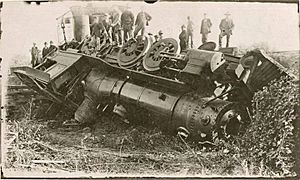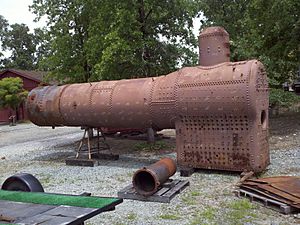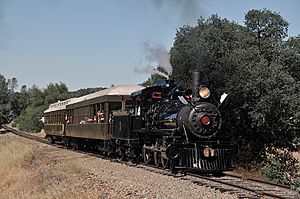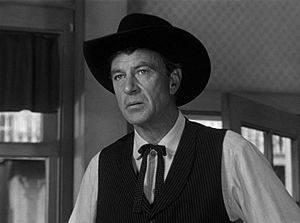Sierra No. 3 facts for kids
Quick facts for kids Sierra Railway No. 3 |
|
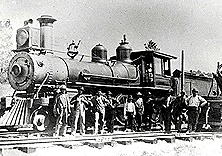 |
|
| Sierra Railway No. 3, circa 1904 | |
| Power type | Steam |
|---|---|
| Builder | Rogers Locomotive and Machine Works |
| Serial number | 4493 |
| Build date | March 26, 1891 |
| Configuration | 4-6-0 |
| UIC classification | 1C |
| Gauge | 4 ft 8 1⁄2 in (1,435 mm) |
| Leading wheel diameter | 2 ft 2 in (0.660 m) |
| Driver diameter | 4 ft 8 in (1.422 m) |
| Boiler pressure | 150 psi (1.03 MPa) |
| Cylinders | Two |
| Cylinder size | 17 in × 24 in (432 mm × 610 mm) |
| Tractive effort | 17,470 lbf (77.7 kN) |
| Official name | W.N. Kelly |
| Retired | 1932 (revenue) |
| Current owner | Railtown 1897 State Historic Park |
| Disposition | Operational |
Sierra Railway No. 3, often called the "Movie Star locomotive", is a 19th-century steam locomotive owned by the State of California and preserved at Railtown 1897 State Historic Park in Jamestown, California. Former Transportation History curator at the Smithsonian Institution William L. Withhuhn described the locomotive's historical and cultural significance:
Sierra Railway No. 3 has appeared in more motion pictures, documentaries, and television productions than any other locomotive. It is undisputedly the image of the archetypal steam locomotive that propelled the USA from the 19th century into the 20th.
Built in 1891, the locomotive returned to operation in July 2010 after a fourteen-year absence from service and a three-year-long overhaul, requiring the replacement of its original boiler.
History
The locomotive, a 4-6-0 ten-wheeler, was built by the Rogers Locomotive and Machine Works of Paterson, New Jersey. Construction of the locomotive was completed on March 26, 1891, and it was given Rogers construction number 4493. It has 17 in × 24 in (43 cm × 61 cm) cylinders, 56-inch (140 cm) driving wheels and weighs 50 short tons (45 t) in working order. It was built for the Prescott & Arizona Central Railway (P&AC) as their locomotive #3 and named W.N. Kelley after the company's treasurer.
The P&AC went bankrupt in 1893 and its owner, Thomas S. Bullock, relocated to California bringing much of his railroad equipment, including the No. 3. He then entered into a partnership with Prince André Poniatowski and William H. Crocker, and together in 1897 they incorporated the Sierra Railway Company of California to connect Oakdale, California with the timber producing regions of Tuolumne County and Calaveras County.
The locomotive became Sierra No. 3 (dropping the W. N. Kelley name) and played a key role of the construction of the railroad to Jamestown, California in 1897, Sonora, California in 1899 and Tuolumne, California in 1900. It was the primary locomotive pulling freight trains on the railroad until 1906, when the Sierra Railway purchased a new Baldwin Locomotive Works 2-8-0 locomotive. It played a significant role in logging, mining and dam building operations in the Sierra foothills.
Originally built to burn coal, the locomotive was converted to burn oil sometime between 1900 and 1902.
Sierra No. 3 was involved in several wrecks. In February 1898, a switch mishap killed conductor William G. Bailey. In September 1899, its tender derailed while backing up on a trestle, causing it to collapse.
The locomotive turned on its side in 1918 just above Sonora, destroying its original wooden cab, which was replaced with a second-hand steel Southern Pacific Railroad cab in February 1919. Two years later, Sierra No. 3 made her first known Hollywood film appearance, in a silent film The Terror starring Tom Mix.
During the Great Depression, the Sierra Railway went into bankruptcy, and was reorganized as the Sierra Railroad Company in 1937. Sierra No. 3 was taken out of service in 1932, and sat on a siding in the Jamestown yard for 15 years. It managed to avoid being scrapped during World War II, and again received attention from Hollywood in 1946, when David O. Selznick, the producer of Duel in the Sun being filmed on the Sierra Railroad, proposed to destroy her in a train wreck scene for the movie. The Sierra Railroad's Master Mechanic Bill Tremewan persuaded the railroad ownership not to consider a notion so "ridiculous", and instead shop crews restored the locomotive to operation for potential charter and movie service.

Inspection of the boiler proved it was in serviceable condition, however the resulting work required a reduction of the Maximum Allowable Working Pressure from 160 to 150 psi (1.10 to 1.03 MPa). The rebuild was completed in 1948, and the locomotive officially returned to service heading a Railway and Locomotive Historical Society sponsored excursion train on May 30. Over the next half-century, Sierra No. 3 pulled tourist excursion trains and appeared in dozens of films, TV shows, and commercials. Among them were High Noon in 1952, for which Gary Cooper won the Academy Award for Best Actor, and Unforgiven, starring and directed by Clint Eastwood, which won the Academy Award for Best Picture for 1992.
The locomotive was often redecorated for various movie and television appearances, one of its most famous roles being the Hooterville Cannonball from the mid-1960s series Petticoat Junction. False smokestacks were also often installed to alter the appearance of the locomotive.
In 1979, Crocker and Associates announced their intention to sell their interest in the railroad to Silverfoot, Inc. based in Chicago, but the deal did not include the locomotive facilities in Jamestown. The complex, including Sierra No. 3, was acquired by the State of California as a result of legislation passed in April 1981, and signed by Governor Jerry Brown. The acquisition was completed on September 15, 1982, and since then, the locomotive has been the property of the State of California.
In 1995, the Federal Railroad Administration issued new safety standards for steam locomotive boilers. In order to comply with these revised regulations, Sierra No. 3 was removed from service until a complete evaluation of the locomotive's condition could be made.
21st-century renovation
Preliminary repairs were completed in 2000–2001 with deferred maintenance funding from the State of California. This included dismantling the locomotive. The project progressed very slowly until 2007, when a major fundraising campaign began. At that time, the budget for the project was estimated at US$600,000, based on the assumption that the existing boiler could be saved.
In a fundraising appeal, Clint Eastwood described Sierra No. 3 as "like a treasured old friend." Eastwood had ridden the locomotive early in his career on the TV series Rawhide, and later used the locomotive in his own movie productions Pale Rider and Unforgiven. Eastwood wrote, "Sierra No. 3 resides at Railtown 1897 State Historic Park. It is housed in the original roundhouse which is still in use. Together these two assets provide a rare opportunity to experience history just as it was 109 years ago." Funding for the renovation project was provided by the California Cultural and Historical Endowment, the Irving J. Symons Foundation, the Sonora Area Foundation, the California State Parks Foundation, the Teichert Foundation, DuPont and many individual donors.
The rebuild included boring out the cylinders and turning the drive wheel tires on a lathe.
When work on the disassembled locomotive resumed, and the boiler was inspected thoroughly by ultrasound testing, it was discovered that a new boiler was necessary. Its old lap seam design made retrofitting it to modern standards too costly, and the risk of the boiler losing its historical integrity was a risk Railtown staff decided not to take. Engineering drawings and other technical assistance needed to build a new boiler were provided by the Strasburg Rail Road in Lancaster County, Pennsylvania. The old boiler was shipped to be used as a pattern to the Chelatchie Boiler Works of Camas, Washington, which fabricated a new welded boiler at a cost of US$600,000. The boiler was then shipped to the historic Southern Pacific shops in Sacramento, California and fitted on the original frame. The locomotive was then trucked back to Jamestown, California for final assembly.
The current configuration of the locomotive represents her appearance during the year 1929, when the movie The Virginian was filmed and provided the first known evidence of the presence of "3-spot's" steel cab. Final cost of the rebuild was US$1.6 million, and the locomotive officially returned to service on July 3, 2010.
Movie appearances
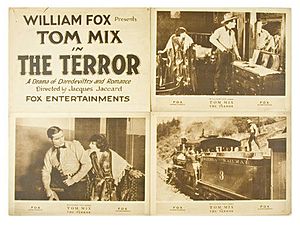
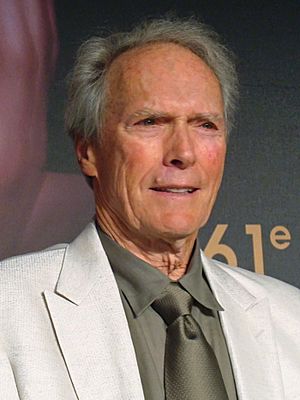
Sierra No. 3 has appeared in many movies. According to Railtown 1897, these include the following:
- The Red Glove, 1919 starring Marie Walcamp and Pat O'Malley.
- The Terror, 1920, starring Tom Mix
- The Virginian, 1929, starring Gary Cooper and Walter Huston. This was the first talkie filmed on location rather than on a studio sound stage. #3 was portrayed as Union Pacific Railroad #3.
- The Texan, 1930, starring Gary Cooper and Fay Wray
- Young Tom Edison, 1940, starring Mickey Rooney
- Sierra Passage, 1950, starring Wayne Morris and Lola Albright
- Wyoming Mail, 1950, starring Stephen McNally, Howard Da Silva and Ed Begley
- High Noon, 1952, starring Gary Cooper, who won the Academy Award for Best Actor for his role. The film won three additional Academy Awards.
- The Cimarron Kid, 1952, starring Audie Murphy and James Best
- Kansas Pacific, 1953, starring Sterling Hayden and Eve Miller, portrayed as Kansas Pacific Railroad #3.
- The Lone Hand, 1953, starring Joel McCrea, Barbara Hale and Alex Nicol
- The Moonlighter, 1953, starring Barbara Stanwyck, Fred MacMurray and Ward Bond
- Apache, 1954, starring Burt Lancaster, Jean Peters and Charles Bronson
- Rage at Dawn, 1955, starring Randolph Scott and Forrest Tucker
- The Return of Jack Slade, 1955, starring John Ericson, Neville Brand and Angie Dickinson
- Texas Lady, 1955, starring Claudette Colbert and Barry Sullivan
- The Big Land, 1957, starring Alan Ladd, Virginia Mayo and Edmond O'Brien
- Terror in a Texas Town, 1958, written under another name by blacklisted screenwriter Dalton Trumbo, and starring Sterling Hayden and Sebastian Cabot
- Man of the West, 1958, starring Gary Cooper, Julie London and Lee J. Cobb
- Face of a Fugitive, 1959, starring Fred MacMurray, Dorothy Green and James Coburn
- The Outrage, 1964, a remake of Rashomon as a western, starring Edward G. Robinson, Paul Newman, Laurence Harvey, Claire Bloom and William Shatner
- The Rare Breed, 1966, starring James Stewart, Maureen O'Hara and Brian Keith
- The Great Race, 1966, starring Jack Lemmon, Tony Curtis and Natalie Wood
- The Perils of Pauline, 1967, starring Pat Boone and Terry-Thomas
- Finian's Rainbow, 1968, starring Fred Astaire and Petula Clark
- A Man Called Gannon, 1968, starring Tony Franciosa and Michael Sarrazin
- The Great Bank Robbery, 1969, starring Zero Mostel and Kim Novak, portrayed as South-Western Texas Railroad #98.
- Joe Hill, 1971, a biopic about the IWW activist Joe Hill, starring Thommy Berggren. The film won the Jury Prize at the 1971 Cannes Film Festival.
- The Great Northfield Minnesota Raid, 1972, starring Cliff Robertson and Robert Duvall
- Oklahoma Crude, 1973, starring George C. Scott and Faye Dunaway
- Nickelodeon, 1976, starring Ryan O'Neal, Burt Reynolds and Tatum O'Neal
- Bound for Glory, 1976, a biopic of Woody Guthrie, starring David Carradine and Randy Quaid. This was the first major film to use the Steadicam, and Haskell Wexler won the Academy Award for Best Cinematography for the film, and the film also won another Academy Award.
- The Apple Dumpling Gang Rides Again, 1979, starring Tim Conway and Don Knotts
- The Long Riders, 1980, starring teams of brothers including James Keach and Stacy Keach, David Carradine and Keith Carradine, and Dennis Quaid and Randy Quaid. Portrayed as Chicago, Rock Island & Pacific #3.
- Pale Rider, 1985, directed by Clint Eastwood, and starring Eastwood and Richard Dysart
- Blood Red, 1986, starring Eric Roberts, Giancarlo Giannini, Dennis Hopper and Julia Roberts in her movie debut
- Back to the Future Part III, 1990, starring Michael J. Fox, Christopher Lloyd and Mary Steenburgen. In what is probably her most famous movie appearance, the engine appears in the scenes set in 1885, six years prior to the engine's actual construction, portraying Central Pacific Railroad #131. While the Central Pacific did have 4-6-0's similar to #3 at the time the film was set, the real Central Pacific #131 was a 4-4-0.
- An American Tail: Fievel Goes West, 1991 animated sequel to An American Tail, where it portrayed as engine No. 7, carrying Fievel Mousekewitz and his family to Green River. Sound effects from the actual locomotive is heard in this film.
- Unforgiven, 1992, directed by Clint Eastwood, starring Eastwood and Gene Hackman and winner of the Academy Award for Best Picture, Academy Award for Best Director and two other Academy Awards
- Bad Girls, 1994, starring Drew Barrymore, Andie MacDowell, Madeleine Stowe and Mary Stuart Masterson
- Color of a Brisk and Leaping Day, 1996, starring Peter Alexander. #3 was portrayed as Yosemite Valley Railroad #27. The real Yosemite Valley #27 was a 2-6-0.
TV appearances
Sierra No. 3 has also appeared in many television shows. According to Railtown 1897, these include the following:
- The Lone Ranger, 1956, starring Clayton Moore and Jay Silverheels.
- Tales of Wells Fargo, 1957, starring Dale Robertson and William Demarest
- Casey Jones, 1958, starring Alan Hale Jr..
- Rawhide, 1959–1966, starring Clint Eastwood and Eric Fleming.
- Overland Trail, 1960, starring William Bendix and Doug McClure.
- Lassie, 1961–1962, starring Jon Provost, June Lockhart and Hugh Reilly.
- Death Valley Days, 1962–1965, starring Ronald Reagan.
- The Raiders, 1963 TV movie, starring Brian Keith and Robert Culp.
- Petticoat Junction, 1963–1970, starring Bea Benaderet, Edgar Buchanan and Linda Kaye Henning. Sierra No. 3 pulled the Hooterville Cannonball passenger train.
- Green Acres, 1965–1971, starring Eddie Albert and Eva Gabor. Sierra No. 3 pulled the Hooterville Cannonball passenger train.
- The Wild Wild West, 1964, starring Robert Conrad and Ross Martin.
- The Big Valley, 1964–1966, starring Barbara Stanwyck.
- The Legend of Jesse James, 1965–1966, starring Christopher Jones and Allen Case.
- Scalplock, 1966 TV movie, starring Dale Robertson and Diana Hyland.
- Iron Horse, 1966–1968, starring Dale Robertson & Gary Owens. #3 portrayed as Buffalo Pass, Scalplock, & Defiance Railroad #3.
- Cimarron Strip, 1967, starring Stuart Whitman and Jill Townsend.
- Dundee and the Culhane, 1967, starring John Mills.
- The Man from U.N.C.L.E., 1967, starring Robert Vaughn and David McCallum.
- Ballad of the Iron Horse, 1967 documentary by John H. Secondari.
- Gunsmoke, 1971, starring James Arness, Amanda Blake and Milburn Stone.
- ’Alias Smith & Jones, 1971-1973, starring Pete Duel, Ben Murphy and Roger Davis.
- Bonanza, 1972, starring Lorne Greene and Michael Landon.
- The Great Man's Whiskers, 1972 TV movie, starring Dean Jones, Ann Sothern and Dennis Weaver, telling the story of why Abraham Lincoln grew his beard.
- Inventing of America, 1975 documentary by James Burke and Raymond Burr.
- Little House on the Prairie, 1975–1983, starring Michael Landon, Karen Grassle and Melissa Gilbert.
- Law of the Land, 1976 TV movie starring James Davis and Don Johnson.
- A Woman Called Moses, a 1978 biopic miniseries about Harriet Tubman, starring Cicely Tyson.
- Lacy and the Mississippi Queen, 1978 TV movie, starring Kathleen Lloyd and Debra Feuer.
- Kate Bliss and the Ticker Tape Kid, 1978 TV movie, starring Suzanne Pleshette.
- The Night Rider, 1979 TV movie, starring David Selby, Pernell Roberts and Kim Cattrall.
- The Last Ride of the Dalton Gang, 1979 TV movie, starring Randy Quaid, Cliff Potts and Larry Wilcox
- Belle Starr, 1980 TV movie, starring Elizabeth Montgomery and Cliff Potts.
- East of Eden, 1981 TV miniseries based on John Steinbeck's novel, starring Bruce Boxleitner, Lloyd Bridges, Warren Oates and Anne Baxter.
- Father Murphy, 1981, starring Merlin Olsen, Katherine Cannon and Moses Gunn.
- The A-Team, 1984, starring George Peppard and Mr. T.
- Bonanza: The Next Generation, 1988 TV movie, starring Michael Landon, Jr. and John Ireland.
- The Adventures of Brisco County, Jr., 1993, starring Bruce Campbell.
- Dr. Quinn, Medicine Woman, 1993, Season 5 Episode 1 "Runaway Train" reuses footage shot for Brisco County Jr.
- Ultimate Restorations Season 1, Episode 3, 10/20/2014.
- Highway to Heaven Season 2, Episode 18, The Long Road Home (1976)



